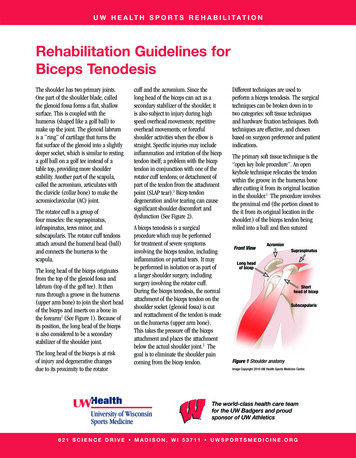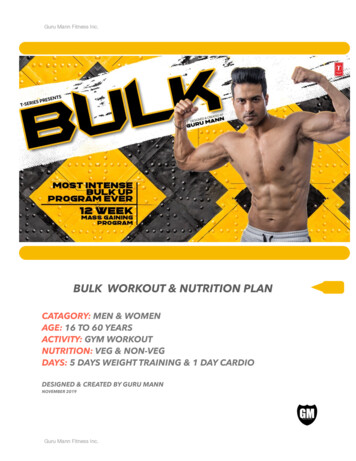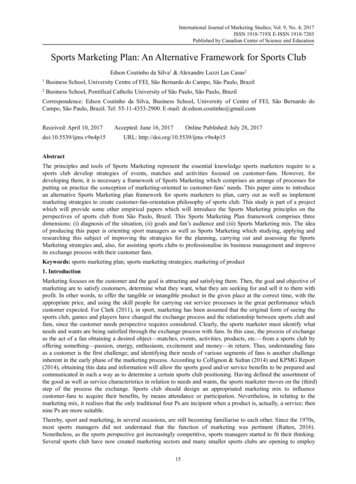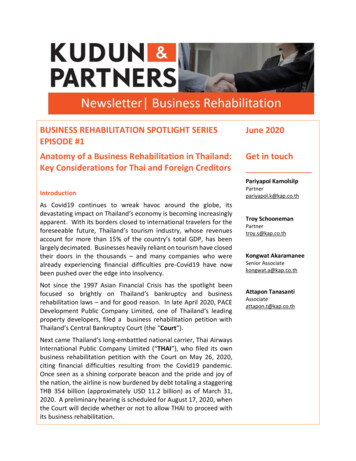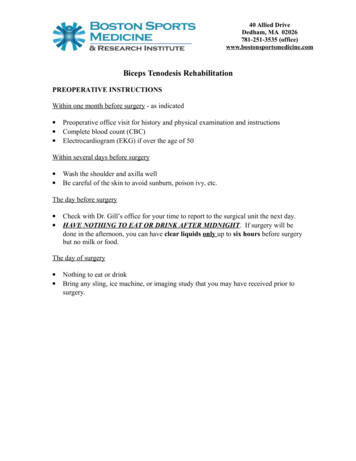
Transcription
40 Allied DriveDedham, MA 02026781-251-3535 (office)www.bostonsportsmedicine.comBiceps Tenodesis RehabilitationPREOPERATIVE INSTRUCTIONSWithin one month before surgery - as indicated Preoperative office visit for history and physical examination and instructionsComplete blood count (CBC)Electrocardiogram (EKG) if over the age of 50Within several days before surgery Wash the shoulder and axilla wellBe careful of the skin to avoid sunburn, poison ivy, etc.The day before surgery Check with Dr. Gill’s office for your time to report to the surgical unit the next day.HAVE NOTHING TO EAT OR DRINK AFTER MIDNIGHT. If surgery will bedone in the afternoon, you can have clear liquids only up to six hours before surgerybut no milk or food.The day of surgery Nothing to eat or drinkBring any sling, ice machine, or imaging study that you may have received prior tosurgery.
40 Allied DriveDedham, MA 02026781-251-3535 (office)www.bostonsportsmedicine.comRehabilitation after Biceps TenodesisPOSTOPERATIVE INSTRUCTIONSYou will wake up in the operating room. A sling and an ice pack will be in place. You will go tothe recovery room and generally will be discharged after 1-2 hours. You can get out of bed whenyou wish. Apply ice to the shoulder to reduce pain and swelling. You may remove the slingwhenever you wish and gently move the elbow, wrist and fingers. Follow Dr. Gill’s instructionsregarding moving your shoulder after surgery.GOALS:1. Control pain and swelling2. Protect the repair3. Begin early shoulder motionACTIVITIES WHEN YOU GO HOME:1. Apply ice to the shoulder as tolerated to reduce pain and swelling. You can changethe dressing to a smaller one to allow the cold therapy to reach the shoulder.2. Remove the sling on the first day after surgery.Move your elbow, fingers and hand several times a day.3. Begin the pendulum exercise several times a dayPendulum exerciseBend over at the waist and let the arm hang down. Using your bodyto initiate movement, swing the arm gently in small circular motions.Repeat for 2 to 3 minutes at a time.4. Remove the outer dressing on the second day after surgery and shower. Leave the little piecesof tape (steri-strips) in place. You can get the wound wet after 2 days in a shower, but do notsoak in a tub. To wash under the operated arm, bend over at the waist and let the arm passivelyswing away from the body. It is safe to wash under the arm in this position.5. Keep your elbow slightly in front of your body; do not reach behind your body.When putting on clothing, lean forward and pull the shirt up and over the operatedarm first. Then put the other arm into the opposite sleeve. To remove the shirt, take theunoperated arm out of the sleeve first, and then slip the shirt off of the operated arm.6. Call Dr. Gill’s office for any concerns, including, but not limited to, severe pain, fevers, chillsor redness.OFFICE VISIT: Please arrange to return to Dr. Gill’s office 10-14 days after surgery forexamination and further instructions.
40 Allied DriveDedham, MA 02026781-251-3535 (office)www.bostonsportsmedicine.comRehabilitation after Biceps TenodesisPhase One: 0 to 4 weeks after surgeryGoals:1. Protect the surgical repair2. Ensure wound healing3. Prevent shoulder stiffness4. Regain range of motionActivities:1. SlingUse your sling most of the time for the first 3 weeks. Remove the sling 4 or 5 times a dayto do pendulum exercises ( fig. 1).2. Use of the operated armYou may use your hand on the operated arm in front of your body but DO NOT raiseyour arm or elbow away from your body. It is all right for you to flex your arm at theelbow. Use of a computer or writing is all right as long as it is not painful.3. ShoweringYou may shower or bath and wash the incision area. To wash under the operated arm,bend over at the waist and let the arm passively come away from the body. It is safe towash under the arm in this position. This is the same position as the pendulum exercise.Exercise ProgramICEDays per Week: 7Times per Day: 4-5As necessarySTRETCHING / PASSIVE MOTIONDays per Week: 7Times per day : 4-5Program:Pendulum exercisesSupine External RotationSupine passive arm elevationBehind the back internal rotation15- 20 minutes1-2 sets1-2 sets1-2 sets1-2 sets20- 30 reps10-15 reps5-10 reps5-10 reps
40 Allied DriveDedham, MA 02026781-251-3535 der stretching is divided into two phases. Phase 1, or passive range of motion, isalways performed with the uninjured arm assisting or helping the operated arm. Phase 2,or active range of motion with a terminal stretch, is performed by the operated arm after3 to 4 weeks, with the uninjured arm assisting for a “terminal stretch”. In most instances,wean off passive range of motion by using the uninjured arm in isolated incidents toassist the operated arm. The other major difference between passive and active stretchingis the “terminal stretch”. During active stretching and upon reaching your “endpoint” ofpain or movement, push the operated arm with the uninjured hand another 5—10 degreesfor additional movement. This final movement is labeled “terminal stretch”. Maximummotion for each person remains the goal and terminal stretching will assist in achievingthat goal.All stretching exercises should be done slowly to maximize muscle and soft connectivetissue involvement. When stretching, your goal is to reach the maximum range of motionfor you. There is a reason for multiple sets and repetitions. This reason stems from“warming up” the shoulder so it can actually stretch further in the last few repetitions thatyou will do. The first few repetitions prepare the stiffened or swollen shoulder for initialmovement.Since there is more than one repetition per set, allow the first one or two repetitions to bewarm—up reps, with very little pain. Gradually work into more and more range ofmotion.It is also important to allow pain to be your guide. Move the arm to an “endpoint” (thatendpoint is dictated by the amount of pain). Your goal is to increase the endpoint as oftenas possible until you have reached the full range of motion. As far as pain, you want toavoid excruciating pain, but “discomfort” is tolerated as long as the pain does not remainfor a prolonged period of time. A basic rule to follow when stretching is, if the pain doesnot linger, you did not stretch too far.1. Pendulum exerciseBend over at the waist and let the arm hang down. Using your bodyto initiate movement, swing the arm gently forward and backwardand in a circular motion.2. Shoulder shrugShrug shoulders upward as illustrated.3. Shoulder blade pinchesPinch shoulder blades backward and together, as illustrated.
40 Allied DriveDedham, MA 02026781-251-3535 (office)www.bostonsportsmedicine.com4. Supine passive arm elevationLie on your back. Hold the affected arm at the wrist with theopposite hand. Using the strength of the opposite arm, lift theaffected arm upward, as if to bring the arm overhead, slowlylower the arm back to the bed.5. Supine external rotationLie on your back. Keep the elbow of the affected arm againstyour side with the elbow bent at 90 degrees. Using a cane orlong stick in the opposite hand, push against the hand of theaffected arm so that the affected arm rotates outward. Hold10 seconds, relax and repeat.6. Behind-the-back internal rotationSitting in a chair or standing, place the hand of the operatedarm behind your back at the waistline. Use your oppositehand, as illustrated, to help the other hand higher towardthe shoulder blade. Hold 10 seconds, relax and repeat.Office VisitPlease arrange to see Dr. Gill approximately 4 weeks following your first post-operativevisit (6 weeks after surgery).
40 Allied DriveDedham, MA 02026781-251-3535 (office)www.bostonsportsmedicine.comRehabilitation after Biceps TenodesisPhase two: the 5th and 6th weeks after surgeryGoals:1. Protect the surgical repair2. Improve range of motion of the shoulder3. Begin gentle strengtheningActivities1. SlingYour sling is no longer necessary unless your doctor instructs you to continue using it(use it for comfort only).2. Use of the operated armYou should continue to avoid lifting your arm away from your body. You can lift yourarm forward in front of your body but not to the side. You may raise your arm to the side,if you use the good arm to assist the operated arm.3. Bathing and showeringContinue to follow the instructions from phase one and the instructions above.Exercise ProgramICEDays per week: 7Times per day : 4-5As necessary15-20 minutesSTRETCHING / ACTIVE MOTIONDays per week: 7Times per day : 3-4Program:Pendulum exercisesSupine External RotationStanding External RotationSupine passive arm elevationSeated-Standing Arm ElevationBehind the back internal rotation1-2 sets1 set1 set1 set1 set1-2 sets20-30 reps10-15 reps10-15 reps5-10 reps5-10 reps5-10 reps
40 Allied DriveDedham, MA 02026781-251-3535 (office)www.bostonsportsmedicine.comExercises1. Pendulum exerciseBend over at the waist and let the arm hang down. Using your bodyto initiate movement, swing the arm gently forward and backwardand in a circular motion.2. Supine passive arm elevationContinue this exercise from phase two, stretching the arm overhead.Hold for 10 seconds.3. Supine / Seated Forward Elevation (Overhead Elbow Lift)During this phase, you can stand or sit in a chair. If it is easier, begin lyingon your back until you achieve maximal motion, then use the standing orseated position. Assume an upright position with erect posture,looking straight ahead. Place your hands on either thigh withthe operated thumb facing up and your elbow straight. Inthe beginning, this stretch is not performed solely with theoperated arm, but use the uninjured hand for assistance going upand coming down. As you become stronger, you can raiseand lower your arm without assistance.The operated arm should be lifted as high as possible, or to yourendpoint of pain. Upon reaching that endpoint, take the uninjured handand actually push on the outstretched forearm of the operated arm. Push 1 or2 inches to achieve a “terminal stretch”. Hold 10 seconds per repetition. Releaseand slowly return to the start position.4. Supine external rotationLie on your back. Keep the elbow of the affected arm againstyour side with the elbow bent at 90 degrees. Using a cane orlong stick in the opposite hand, push against the hand of theaffected arm so that the affected arm rotates outward. Hold10 seconds, relax and repeat.5. Standing external rotationStand with the operated shoulder toward a door frame asillustrated. While keeping the operated arm firmlyagainst your side and the elbow at a right (90 degree)angle. By moving your feet, rotate your body away from thedoor to produce outward rotation at the shoulder.
40 Allied DriveDedham, MA 02026781-251-3535 (office)www.bostonsportsmedicine.com6. Behind-the-back internal rotationSitting in a chair or standing, place the hand of theoperated arm behind your back at the waistline.Use your opposite hand or pull on a towelto help the other hand higher toward the oppositeshoulder blade. Hold 10 seconds, relax and repeat.Office visitPlease arrange an appointment to see Dr. Gill in 8 weeks (3-4 months from surgery).
40 Allied DriveDedham, MA 02026781-251-3535 (office)www.bostonsportsmedicine.comRehabilitation after Arthroscopic Shoulder Labrum RepairPhase Three: starting 6 weeks after surgery onwardGoals:1. Protect the surgical repair2. Regain full range of motion3. Continue gentle strengtheningActivities:Use of the operated armYou may now safely use the arm for normal daily activities involved with dressing ,bathing and self-care. You may raise the arm away from the body. However, you shouldnot raise the arm when carrying objects greater than one pound. Any forceful pushing orpulling activities could disrupt the healing of your surgical repair.Exercise ProgramSTRETCHING / ACTIVE MOTIONDays per week: 7Times per day : 1-2Pendulum exercisesStanding External Rotation / DoorwayWall Climb StretchSupine external Rotation with AbductionStanding Forward FlexionBehind the back internal rotationSupine Cross Chest StretchSide-lying External Rotation / 1 lb.Prone Horizontal Arm Raises / 1 lb.STRENGTHENING / THERABANDExternal RotationInternal RotationStanding Forward PunchShoulder ShrugSeated RowBiceps curl1-2 sets1 set1 set1 set2 sets1-2 sets1 set1 set1 set1-2 sets1-2 sets1-2 sets1-2 sets1-2 sets1-2 sets20-30 reps5-10 reps5-10 reps5-10 reps10-20 reps5-10 reps5-10 reps10-20 reps10-20 reps15-20 reps15-20 reps15-20 reps15-20 reps15-20 reps15-20 reps
40 Allied DriveDedham, MA 02026781-251-3535 (office)www.bostonsportsmedicine.com1. Supine external rotation with abductionLie on your back. Place your hands behind your head as shown inillustration 1a. Slowly lower the elbows to stretch the shouldertoward the position shown in illustration 1b. Hold for 10 seconds,then return to the starting position. When your elbows are able tocomfortably reach the surface that you are lying on, then you canstart the ‘corner stretch’.2. Supine cross-chest stretchLying on your back, hold the elbow of the operatedarm with the opposite hand. Gently stretch the elbowtoward the opposite shoulder. Hold for 10 seconds.3. Wall climbStand facing a wall, place the fingers of the affected arm on the wall.Using the fingers as “feet”, climb the hand and arm upward. As youare able to stretch the hand and arm higher, you should move yourbody closer to the wall. Hold 10 seconds, lower the arm by pressingthe hand into the wall and letting it slide slowly down.4. Standing forward flexionStand facing a mirror with the hands rotated so that the thumbs faceforward. Raise the arm upward keeping the elbow straight. Try to raise the arm byhinging at the shoulder as opposed to raising the arm with the shoulder blade.Do 10 repetitions to 90 degrees. If you can do this without hiking the shoulderblade, do 10 repetitions fully overhead.5. Side-lying external rotationLying on the non-operated side, bend your elbow to a 90degree angle and keep the operated arm firmly against yourside with your hand resting on your abdomen. By rotationat the shoulder, raise your hand upward, toward the ceilingthrough a comfortable range of motion. Hold this positionfor 1 to 2 seconds, then slowly lower the hand.
40 Allied DriveDedham, MA 02026781-251-3535 (office)www.bostonsportsmedicine.com6. Prone or bent-over horizontal arm raiseLie face down on your bed with the operated arm hangingfreely off of the side (or bend over at the waist as if doingpendulum exercises). Rotate your hand so that the thumbfaces away from you. Slowly raise your arm away fromyour body through a pain-free range of motion. Hold thatposition for 1 to 2 seconds and slowly lower.Theraband StrengtheningThese resistance exercises should be done very slowly in both directions. Your goal is toachieve a maximum amount of strengthening while listening to your endpoint of pain.Obviously, we want to strengthen you throughout the full range of motion. It is veryimportant that this exercise be done very slowly, not only when you complete theexercise (concentric), but also as you come back to the start position (eccentric). Theslower the motion, the more maximal the contraction throughout a full range of motion.1. External RotationAttach the theraband at waist level in a door jamb or other. While standingsideways to the door and looking straight ahead, grasp one end of the bandand pull the band all the way through until it is taut. Feet are shoulderwidth apart and the knees are slightly flexed. The injured elbow is placednext to the side with the injured hand as close to your chest as possible(think of this elbow as being a hinge on a gate). Taking the cord inthe injured hand, move the hand away from the body as far as it feelscomfortable (at least 90 degrees is our goal), or to where the endpoint ofpain limits you. Return to the start position; if you would like, duringfuture repetitions go a few more degrees to work more of a range of motion.2. Internal RotationAttach the Theraband at waist level in a doorjamb or other. Whilestanding sideways to the door and looking straight ahead, grasp one endof the handle and pull the cord all the way through until it is taut. Feet areshoulder width apart and the knees are slightly flexed. The injured elbowis placed next to the side and is flexed at 90 degrees (think of this elbowas being a hinge on a gate). Taking the cord in the injured hand, movethe hand toward the chest as far as it feels comfortable, or to where theendpoint of pain limits you. Return to the start position
40 Allied DriveDedham, MA 02026781-251-3535 (office)www.bostonsportsmedicine.com3. Shoulder ShrugStand on the theraband with your feet at should width apart and. Lookstraight ahead. Next, straighten up, keeping the knees slightly flexed,with your arms straight down at the sides (palms in). Slowly raise theshoulders in a shrug (toward the ears), then rotate the shouldersbackward in a circular motion, and finally down to the original position.This movement is completed while keeping constant tension on the cord.4. Seated / Standing RowAttach the theraband to a door jam or other object. Sit or stand facing thedoor. Use a wide flat—footed stance and keep your back straight.Begin with the arms slightly flexed, hands together at waist level infront of your body, thumbs pointing upward, and with the cord taut.You are producing a rowing motion. Pull the cord all the way towardthe chest. While pulling the cord, the elbows should be drawn alongthe side of the body until the hands touch the lower ribs. Always returnslowly to the start position.5. Standing Forward PunchAttach the theraband at waist level in the door jamb. Facing away fromthe door, stand in a boxing position with one leg ahead of the other(stride position). Do not bend at the waist and remain in an uprightposition. If the right shoulder is the injured extremity, you will want tograsp the handle in the right hand and step out until the cord is taut. Ifyou use the right hand, the left foot should be forward in the stride position.Begin with your right arm at waist level and bend the elbow at a 90degree angle, with the elbow remaining near your side. Slowly punchforward while slightly raising the right arm in a forward, upward punchingmotion. The hand should reach approximately neck level with the rightarm almost straight.6. Biceps CurlsPlace your feet on the cord, shoulder width apart, knees slightly bent.Keeping your elbows close to the sides of your body, slowly bend thearm at the elbow and curl towards the shoulder. Alternate arms whileperforming this exercise.Office VisitPlease arrange an appointment with Dr. Gill’s office in 8 weeks (3-4 monthspost-surgery).
opposite hand. Using the strength of the opposite arm, lift the affected arm upward, as if to bring the arm overhead, slowly lower the arm back to the bed. 5. Supine external rotation Lie on your back. Keep the elbow of the affected arm against your side with the elbow bent at 90 degrees. Using a cane or
